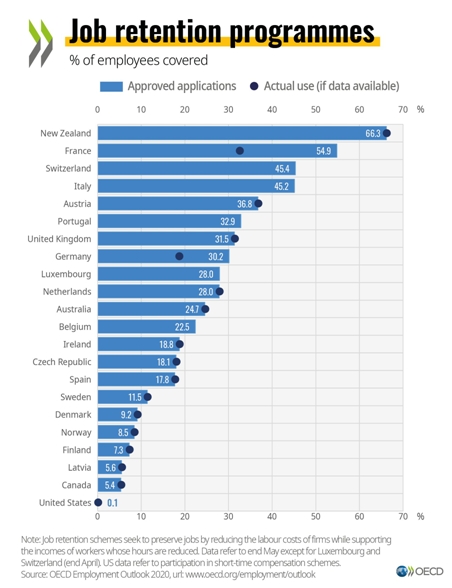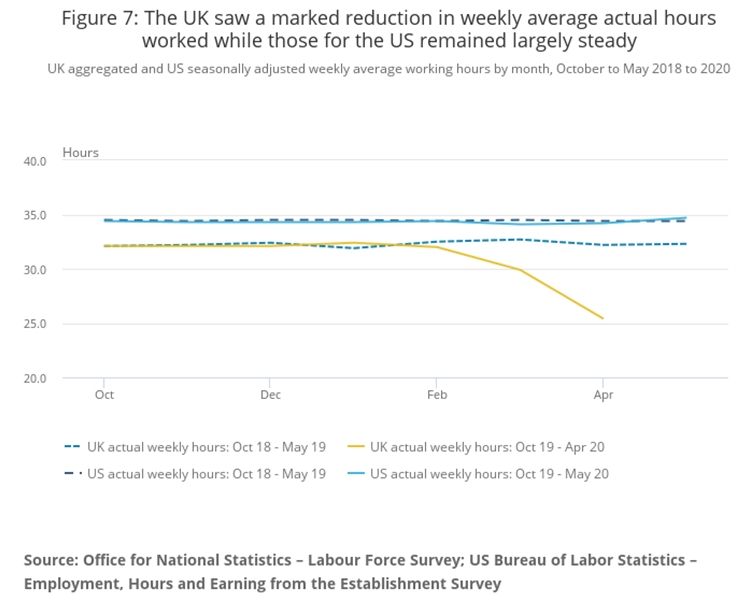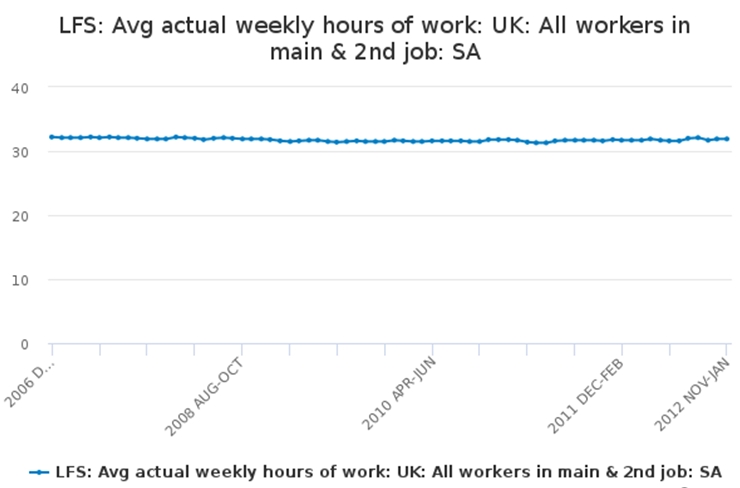By Tom O’Leary
The enormous loss of jobs in recent weeks will not be halted by the miserable ‘summer statement’ announced by the government. In fact, the flow of job losses is a direct result of government policy itself, in particular how it is ending the furlough scheme. Despite intense public (and presumably private lobbying) from both employer organisations and trade unions, the Chancellor Rishi Sunak made no changes to the furlough scheme, which is widely described as a ‘cliff edge’ for jobs.
The cliff edge
The jobs furlough scheme is being phased out with employers having to meet 20% of pay for retained workers from August. The scheme will end entirely in October. The government claims that the scheme is uniquely comprehensive and generous. These claims are false.
Fig. 1 from the OECD shows the number of employees covered by the job retention scheme in the UK is less than a third of the total. This is very far from the best in the OECD and does not include at all the large numbers of self-employed, many of who have been forced into fake self-employment over several years. It should be noted too that actual job retention for employees in the US is virtually non-existent.
Fig1. Job Retention Schemes in the OECD

But soon even these supports will be kicked away. From August 1st, employers will need to pay 20% of wages of retained workers and from October 1st they will have to pay 100%. The businesses that are currently generating little or no income will lay off workers rather than have to pay even 20% of wages. Come October, the vast majority of businesses who are failing to generate profits will lay off workers or severely cut pay both, or both.
The reason for the wave off announced job losses now is because of statutory requirements to consult with the workforce about job losses. The consultation period varies according to the size of job losses – 30 days for layoffs for up to 100 workers, 45 days for 100 or more.
Critics are right to call it a cliff edge. It is because of this sudden and brutal withdrawal of even the inadequate support for furlough that companies are announcing the job losses now. And the wave of announced job losses is enormous, and with a far greater proportion likely to be done without any fanfare.
The job losses announced in July alone include Jaguar Land Rover, Poundstretcher, Bella Italia, Harrods, Arcadia, John Lewis, Accenture, Upper Crust, Café Ritazza, Harveys, TM Lewin and Royal Mail. Other companies have threatened job losses to achieve pay cuts, Ryanair, Mirror Group Newspapers and BA among them.
Against this backdrop, both the scale and composition of the government’s ‘Plan for Jobs’ (pdf ) is wholly inadequate. A combined package of £30 billion is equivalent to just 1.4% of GDP, the type of small stimulus that would be appropriate coming out of a mild recession.
Worse, the package is best characterised as a series of small subsidies to businesses. Yet many of these consumer businesses will continue to fail because the government has failed to get the virus under control. School attendance, footfall in shops and even pub going remain massively below where they would normally be because the majority of the population is right to remain extremely wary of a return to normal. Paradoxically, in putting profits first at every stage rather than public health, the government has deepened and prolonged the economic crisis.
The private sector in general will only retain workers or maintain investment levels if there is a prospect of profits. These small-scale subsidies are largely irrelevant to profitability. At best they are one-off windfalls to businesses who will not change their plans as a result. The ‘Plan for Jobs’ will fail.
Remembering 2008 to 2010
There is a remarkable propensity to forget what happened in the crisis of 2008 onwards. This is especially dangerous in the current period, because lessons from that period are vital in understanding the current threat to jobs, pay and living standards.
The persistent claims that ‘the Tories are implementing Corbyn’s policies’, or ‘the Tories have abandoned austerity’ are especially dangerous because they disarm the labour movement in face of the offensive to restore profits that has already begun.
The fall in profits in the UK began in 2007, leading to full-blown recession in 2008. The initial policy response was to bail out banks and big businesses in 2008 to 2009. Only as the economy stopped contracting was a vicious austerity programme introduced in 2010.
When the Chancellor announced £330 billion in bail-out measures in March this year he was simply repeating that sequence. The austerity is in the pipeline.
But history will not simply repeat itself, for two reasons. It was extremely difficult for businesses to impose big real terms cuts in pay from 2008 onwards because unemployment did not rise sharply and inflation remained low. Achieving cuts in nominal pay (before inflation) under those circumstances is extremely difficult for businesses. Instead, they relied on the government cutting real wages in the public sector from 2010 onwards in order to lower them across the economy, but with only limited success.
Now, the downturn is much more severe and the government is attempting to ensure that businesses can take full advantage of the crisis. The depth of this crisis is shown in the chart below, in latest data from the Office for National Statistics (ONS) on average hours worked, which compares US and UK average hours worked versus the same periods in the previous 12 months.
Chart 1. UK and US Average Weekly Hours Worked to May 2020, per Employee

In the UK, average hours worked in April were 25.4. This compares to 32.2 hours in April 2019, a fall of almost 27% per cent. As labour is the most important factor in production, it is impossible for a fall of this size not to produce an extremely large fall in output.
This is in sharp contrast to the crisis of 2008 onwards, shown in Chart 2 below. Average weekly hours also peaked at 32.2 hours in February 2008. The low-point was 31.3 hours in April-May 2011, a much more modest decline of 2.9%.
Chart 2. UK Average Weekly Hours Worked in 2008 to 2012

On this measure, of average weekly hours lost per employee, the current crisis is qualitatively worse than in the recession of 2008 onwards.
The alternative
The ‘Plan for Jobs’ approach will fail because, as in 2008 to 2010 the policy relies on subsidies to the private sector to revive the economy even though it is unwilling or unable to rehire and invest. On both occasions, pro-business governments refused to do what was necessary to revive the economy because this would interfere with the workings of the private sector.
So, (necessary) schools rebuilding programmes are permissible because they do not involve state ownership of the means of production. The state taking control of failing railways, or investing in new renewable energy production are both ruled out. This is because the state then would then become a bigger economic agent, preventing the direct accumulation of profits in some sectors. This would be to overturn the entire policy of the last 40 years, which has been to allow the private sector ever greater ownership of the means of production through privatisation and outsourcing.
One obvious response to the jobs crisis is to share the work available and demand a 4-day week. This has already been raised by MPs, led by the Labour left, and could be taken up by trade unions. But it is imperative that this demand is raised in conjunction with the simultaneous demand for no loss of pay. Otherwise, there is simply the danger of facilitating the threats from BA and Ryanair, who have imposed huge pay cuts under the guise of job-sharing.
But it should be clear that huge attacks on the working class are coming. In fact they have already begun. The labour movement needs to resist these otherwise it will suffer very heavy blows.

Recent Comments